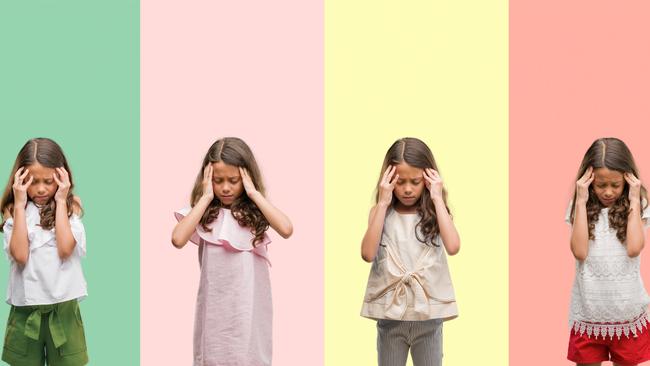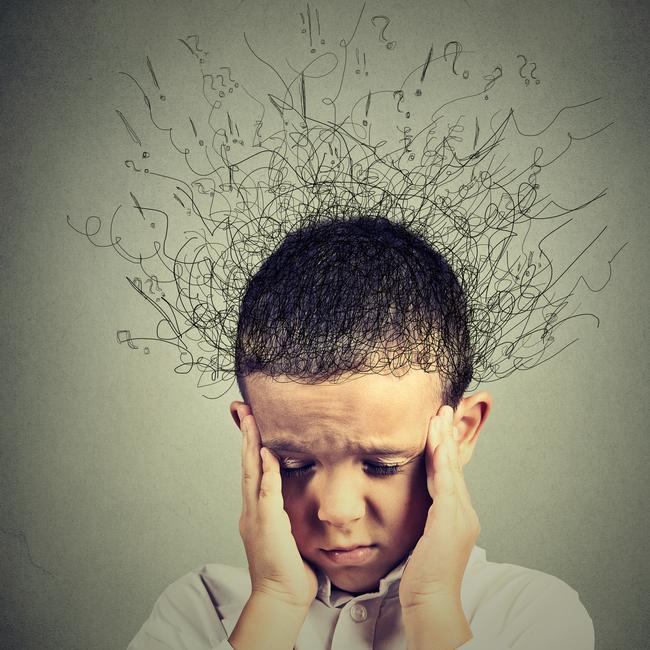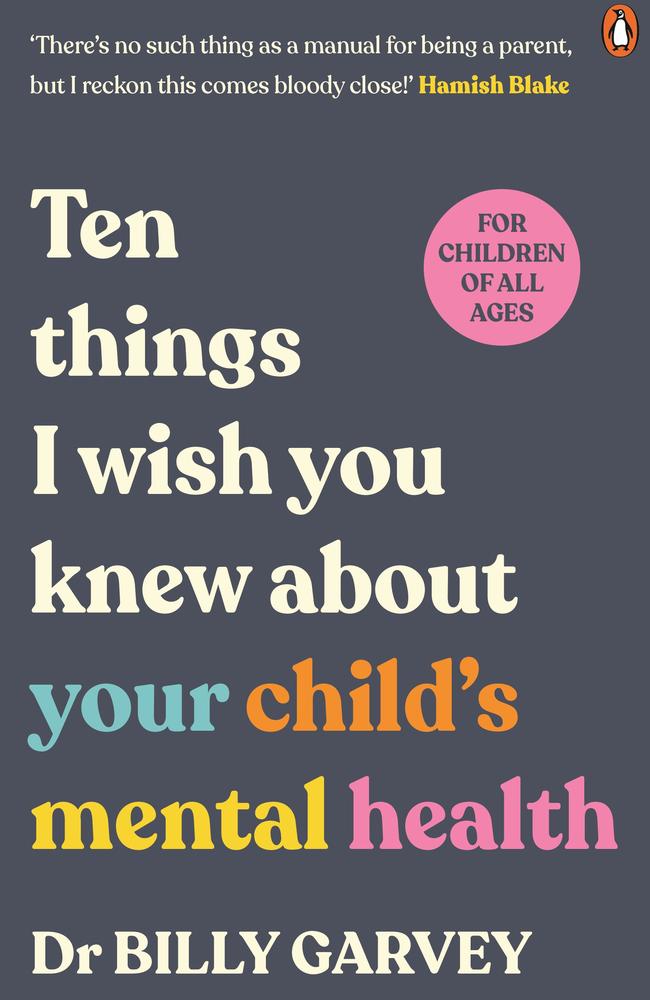
Over 50 per cent of adult mental illness begins in childhood, and the sooner it is identified and treated, the greater chance we have of making sure those children don’t experience ongoing problems. The problem is, however, that we miss so many early signs that a child is struggling.
Think about how hard it is for us as adults to understand and share our own challenging emotions. For children it is much harder, as their brains are still developing intellectually, emotionally and socially.
One of the key things they struggle with is anxiety. In fact, more children and adults suffer from anxiety than any other mental illness, including depression.
Phillip was a 10-year-old boy who had been sent to see me due to difficulty leaving his house. Phillip wasn’t able to talk to me at that first appointment. In fact, his mum told me he rarely spoke to anyone, and it had been a huge effort just to get him into the clinic that morning to see me.
She said that Phillip had been a really happy and active child with no significant concerns up until about two years ago.

Looking back, she and her husband noticed that the first signs were occasional tummy aches before school. Initially they thought something might be wrong with his digestive system, so they took Phillip to see their GP. All the tests came back normal, but the tummy aches got worse. Then they tried ignoring them, hoping with time he would stop mentioning them, gently reassuring him when he persisted that the doctor had said nothing was wrong.
Within a couple of months Phillip wasn’t able to get out of bed in the morning for school, missing the first part of every school day. Then he started missing entire days and then weeks at a time due to tummy aches and tiredness.
When I first met Phillip, he had missed an entire year of school. Not only that, he could no longer leave the house, often only eating meals in his room, playing video games and watching cartoons. His parents were at a loss as to how they could turn things around. They missed their happy and chatty boy who loved school and his friends there.
We often think of anxiety as a problem teenagers have, but in fact it commonly begins much earlier, as it did in Phillip.

All children need to experience fear and worries to learn to handle and resolve these types of experiences, but if children don’t manage to navigate these fears successfully, it can impact mental health.
During the first few years of life, separation from caregivers and interactions with strangers often triggers fear in children.
In toddlers this is usually not concerning, but when observed in school-age children it can mean support is required. Selective mutism, a form of anxiety in which children will not speak in certain environments, is usually seen in children before they start school, and needs to be approached from a mental health, not a speech, perspective.
In school, the need to fit in can lead to performance anxiety and worries of peer rejection. Separation anxiety, where children struggle to separate from their primary caregivers, is another form of clinical anxiety affecting children who are on average seven years old. It also needs to be approached carefully to avoid future mental difficulties later in life. Even the teenagers we meet in the clinic who have generalised anxiety, social anxiety or panic attacks, often first started to struggle during primary school.
Helping children learn to understand these feelings and come up with ways to deal with them in healthy ways requires specific skill development.
We need to help them identify feelings of fear and worry, teach them words to describe these feelings and communicate them to others, and then learn ways to process these experiences that allows the child to succeed in their daily activities and relationships.

From around eight or nine years of age, children start to compare themselves to their peers in an attempt to fit in. School can be a really daunting experience, too, as children start to participate in more obvious forms of evaluation such as presentations and tests. This was when Phillip started to get his symptoms of anxiety. At first it was the night before a school presentation, but then it progressed to any school day due to the fear of being asked to answer a question in class. Phillip had no intellectual or learning concerns, but this didn’t fix his fear of failure and social rejection.
With time he was so afraid of being overwhelmed and rejected that it had escalated to being unable to leave the house.
People are often tempted to make kids with mental illness face what they fear – a strategy known as “exposure”.
I think the expectation is that after a pep talk or a break from the situation, the child will be better able to deal with it. Exposure, however, should not be the first step in managing an anxiety-invoking situation, and telling Phillip he needed to be back in school would have only increased his anxiety.
Instead, we guided him to recognise the signs in his body that signalled his anxiety. This awareness of what our body is telling us is called “interoception”. For Phillip, this was nausea and a tightness in his tummy. For others it might be the awareness of their heart racing, a headache, feeling hot or a tingling sensation in parts of their body.

Once we’d identified Phillip’s early signs of anxiety, the next step was to figure out what helped to control those feelings by switching off the fight or flight response.
Phillip liked music and found deep breathing calming, so when he started to feel sick or the tight feeling in his stomach, we asked him to find a calm place and go through some breathing exercises that we taught him to help calm his nervous system.
Phillip, at age 10, was skilled enough in his development that he could start to use these techniques on his own, to give him back his sense of control over those overwhelming experiences.
He would take a deep, slow breath in, pause, and then slow breath out, focusing on the air moving through his nose and the rise and fall of his tummy. If this strategy didn’t resolve his anxiety within five to 10 minutes, he would then listen to music somewhere on his own until he felt calm again. We also set up sessions with a psychologist.
Philip now attends school full-time, and he and his teacher have a subtle signal to use when he’s feeling anxious so that he can leave the class without raising too much attention.

ANXIETY IN KIDS
■ Anxiety is a normal emotional response to many situations and can be an appropriate and helpful part of life. It becomes concerning when it has a negative impact on how well a person functions or their quality of life. Anxiety occurs in approximately 20 per cent of children and teenagers.
■ Symptoms of anxiety include withdrawal and avoidance, anger and outbursts, trouble falling asleep or frequent waking through the night, always needing reassurance, trouble concentrating, changes in appetite and physical symptoms such as headaches, nausea, tummy pain, dizziness and muscle cramps.
■ There are also many others forms of anxiety. These have additional signs, including separation anxiety, social anxiety, selective mutism, specific phobia, panic disorder and obsessive compulsive disorder.
■ Other signs that anxiety has reached a concerning level are restlessness, fatigue, difficulty concentrating, irritability, sleep difficulties and muscle tension. Very few kids can say they are anxious and many will either withdraw, become irritable or complain of feelings in their body such as headaches or tummy pain.

STRATEGIES FOR PARENTS
■ Helping everyone in the family to learn about anxiety is a really great way to build mastery of our feelings, especially the difficult ones. Understanding what can trigger worry and fear and what happens in our body when these feelings happen helps to know when it’s present, but also shows kids it’s OK.
■ When children do become anxious, we must make sure we never dismiss it. Leaving a child to face their fears on their own will worsen those feelings, and risks that they won’t tell you about them in the future.
■ We should all be constantly learning what works best to help calm us in these tough moments. All children need guidance with this, and it is different for every child. Common approaches tap into calming down the alarm system in our body. Moving to less stimulating spaces helps to settle the alarm in many children, and activities like deep breathing help us to focus on our bodies and the present moment. This can be done from a young age.

KEY LESSONS
■ Feeling anxious is a common and helpful part of life, and all children will experience it to a certain degree. Like all emotions, experiencing anxiety during childhood is an opportunity for kids to be supported in learning how to deal with it.
■ Anxiety becomes concerning when it happens frequently and leads to difficulties functioning at home or school. Common triggers can be separating from a caregiver, social interactions and environments where judgment may occur (for example, the classroom).
■ When children are showing excessive anxiety, it is important to support them to understand these feelings and how to manage them. It is different for each child, but management often involves a child learning and practising ways to settle their nervous system,
such as deep breathing, tensing and relaxing muscles, or listening to music.

Add your comment to this story
To join the conversation, please log in. Don't have an account? Register
Join the conversation, you are commenting as Logout
One dead after rock star’s jet crashes
One person has been killed and others injured after a rock star’s private jet veered off the runway at a US airport.
Hottest holiday deals of 2025 you need to book now
Byron Bay to Japan, Bali and Tasmania. There are cheap holiday deals on offer this year but you need to know when and how to book to maximise the savings.